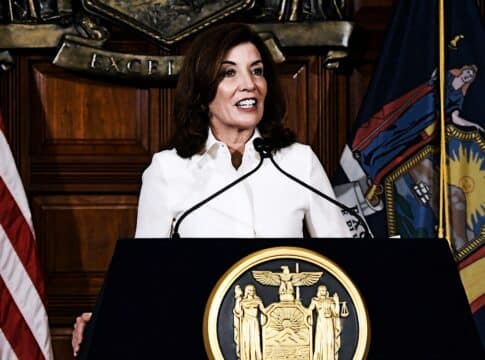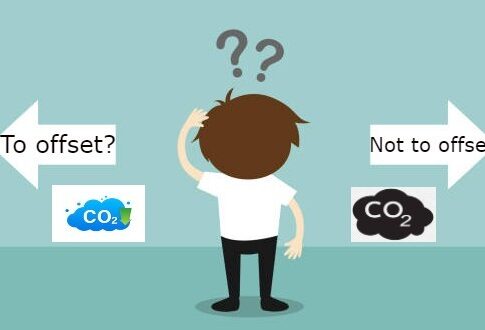New York to Cap-and-Invest $1B Carbon Credits from Big Polluters
New York State Gov. Kathy Hochul revealed a first-in-the-nation carbon credits program that put an economy-wide price on pollution to ditch fossil fuels and reduce GHG emissions.
New York has been taking one of the most ambitious efforts in the United States to address the climate crisis. The state aims to achieve its mandate of 40% emissions reduction by 2030, and at least 85% by 2050 from 1990 levels.
Hochul’s new Cap-and-Invest Program would put New York on the path to meet those climate goals.
It will allow the state to make more critical investments in the clean energy transition. It will also support vulnerable and disadvantaged communities amid the rising energy prices.
Gov. Hochul said:
“Our ambitious Cap-and-Invest Program sets a cap on greenhouse gas emissions and shares the revenues with New Yorkers from disadvantaged communities to help cover utility bills, transportation costs and decarbonization efforts. Through our innovative efforts, we will create a cleaner, greener future while helping New Yorkers with the costs of the transition.”
The program, if adopted, can be one of the most sweeping climate plans in the country.
New York And Its New Carbon Credit Program
New York wouldn’t be the first to adopt this carbon credits program. California has its own cap-and-trade program while Washington and Oregon have their own approaches in place, too.
But the design of the country’s 3rd largest economy will be the most rigorous, if adopted.
The “Cap-and-Invest” program will require businesses to buy allowances, also known as carbon credits, to pollute. The number of credits – or the cap – is reducing gradually in line with the state’s climate goals.
The government will then invest the revenues earned from the cap in various efforts that slash carbon emissions. These include the following initiatives:
Installing electric vehicle chargers
Replacing fossil fuel appliances with electric ones
Weatherizing buildings
Making energy or power affordable
The proposed plan calls for no on-site fossil fuel combustion for constructing smaller buildings by 2025 and bigger buildings by 2028. It also prohibits the sale of new fossil fuel heating equipment by the end of this decade.
Gov. Hochul also said that an existing program, EmPower Plus, will expand to reach 20,000+ low-income households this year by giving them dwellings with no-cost energy efficiency solutions.
She further added that the state will allocate $200 million to 800,000 customers making below $75,000 to pay electric bills via a relief credit.
Large-scale GHG emitters and distributors of heating and transportation fuels will be required to buy carbon credits associated with their polluting activities.
By putting a price for each metric ton of carbon emissions, the Cap-and-Invest program will incentivize consumers, companies, and other entities to transition to a lower-carbon economy.
Cap-and-Invest Program Principles
The Department of Environmental Conservation (DEC) and the New York State Energy Research and Development Authority (NYSERDA) will run and oversee the program. Under Gov. Hochul’s direction, the program design will prioritize 5 core principles.
Affordability:
A crucial part of the cap-and-invest program is the creation of a universal Climate Action Rebate. The goal is to drive ~$1 billion in cap-and-invest revenues to New Yorkers each year. This is meant to help mitigate costs to consumers and preserve funds for consumer-led decarbonization efforts.
Climate Leadership:
New York’s new carbon credits program will not only help meet the state’s mandated climate targets; it will further drive a nationwide approach to carbon pricing. Thus, Gov. Hochul plans to design it in a way that it aligns with other programs that lower the cost of transitioning to a greener future.
Job Creation:
The new climate program will also create new investment opportunities that create a lot of jobs. The proceeds will go into just transition initiatives ensuring no worker is left behind. The state industries will also be put in a competitive advantage while stimulating the clean energy movement.
Prioritizing Disadvantaged Communities:
The proposal ensures that the burden of carbon emissions are reduced in frontline, disadvantaged communities. It will slate at least 35% of investments under the plan to them. Hochul highlighted that they’ve suffered injustice already and deserved no more burden, saying:
“As we work to drive down polluting emissions across the board, we must make sure that those who have already suffered from environmental injustice no longer bear an unfair share of the burden.”
Funding a Sustainable Future:
New York’s cap-and-invest will provide funds crucial in achieving the state’s climate goals. The proceeds will support projects that reduce energy bills, electrify business operations, and increase energy efficiency, among others.
The innovative program will get inspiration from the experience of similar programs that resulted in significant emissions reductions. The state’s electricity system is already part of a regional cap-and-invest style program, the Regional Greenhouse Gas Initiative (RGGI).
Since its establishment in 2005, the RCGI has helped cut emissions from power plants by over 50%. It has also raised about $6 billion to support cleaner energy solutions among the participating states.
The post New York to Cap-and-Invest $1B Carbon Credits from Big Polluters appeared first on Carbon Credits.



